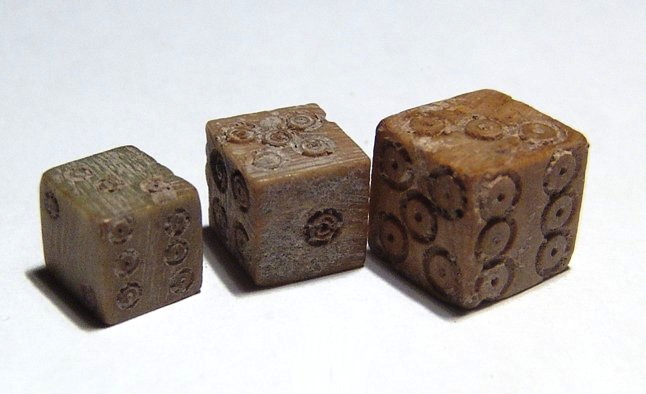
“A lot of 3 Roman carved bone dice, c. 1st - 3rd Century AD, each neatly carved with good style.”
Largest 9mm in width.
Ex Los Angeles private collection originally purchased by that collector in Israel in the early 1980’s. Purchased for collection Calculant at auction (Ancient Resources LLC), 4 May 2014.
One might think that dice are out of place in this collection, as they are not precisely calculating machines. But as devices for sampling the mysteries of chance, by throwing up numbers, the use of astragali or “knucklebones” and dice for this purpose have played an important role in cultures stretching back some six millennia. Evidence of the use of these in board games stretches back at least to the First Dynasty in Egypt (3,500 BC),1 and dice had certainly evolved by 1,500 BC.2 However, since the concept of randomness was less well established, the belief that the outcome of throwing them should be determined by the will of gods, led to their natural role in divination and prognostication. Also, the representation of number upon them, as seen in the above examples, was not necessarily indicated by the written number system, but as in modern dice, could be represented directly by groupings of dots. The close relationship between these simple devices, and central cultural practices from religion to recreation, and interest in how different outcomes or combinations of outcomes might be predicted, was another strand in the development of need and capacity in numeracy, and lay at the root of the modern concept of probability which informs so much of modern organisation.
1 E. N. David, Games, Gods & Gambling, Hafner Publishing Company, New York, 1962, p. 4. (↑)
2 ibid, p. 5. (↑)
Pages linked to this page
 This work by Jim Falk is licensed under a Creative Commons Attribution-NonCommercial-NoDerivs 3.0 Unported License Click on the logo to the left to see the terms on which you can use it.
This work by Jim Falk is licensed under a Creative Commons Attribution-NonCommercial-NoDerivs 3.0 Unported License Click on the logo to the left to see the terms on which you can use it.